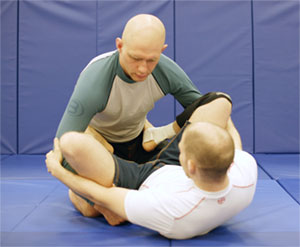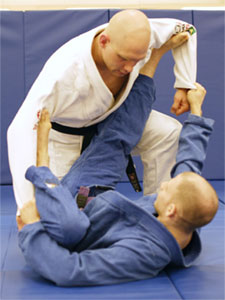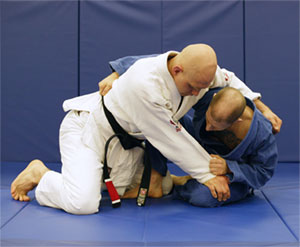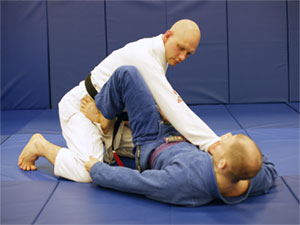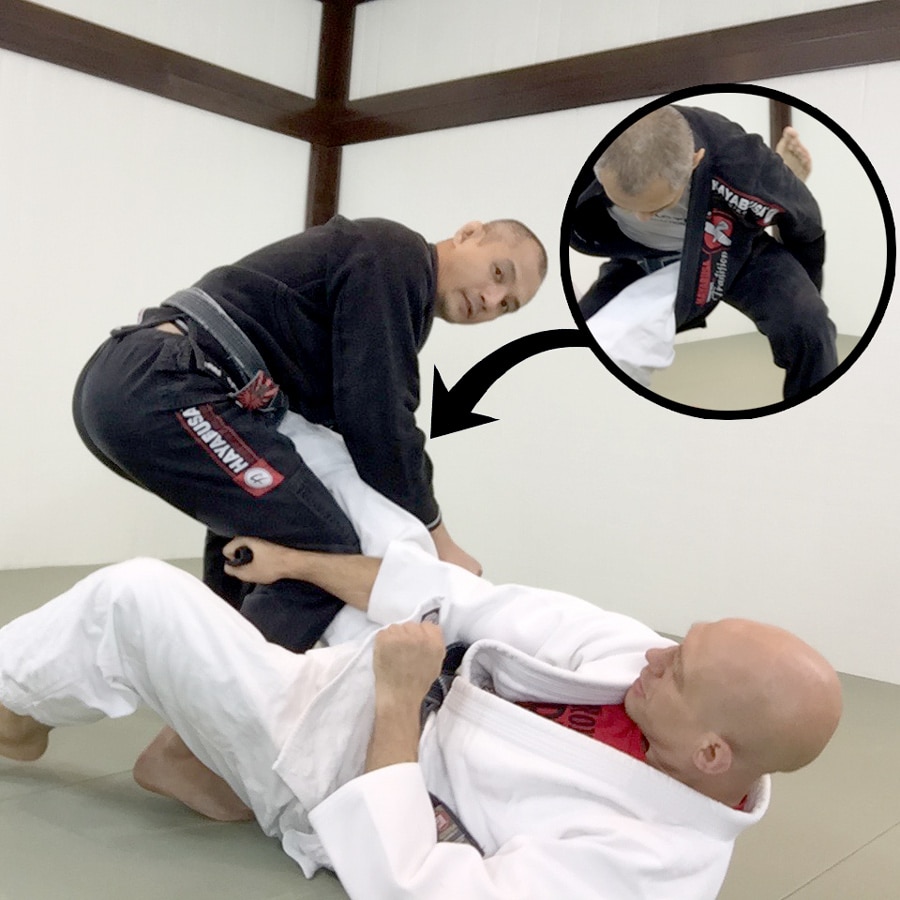By Stephan Kesting and Elliott Bayev
Principal Photography by Keith Haist
Originally Published in Ultimate Grappling Magazine
This is the second of three articles discussing variations of the Brazilian Jiu-jitsu guard position. In this article we are going to focus on the Open Guard, where your legs are NOT locked around your opponent’s torso (the other articles cover the Closed Guard and the Half Guard). Just because your legs aren’t closed doesn’t mean that you can’t control or attack your opponent – far from it! There are many positional variations, sweeps and submission setups for the Open Guard, making it the bread and butter for many Jiu-jitsu competitors.
You can transition deliberately from the Closed Guard to an Open Guard, or your opponent can do it for you by forcing your ankles to uncross as part of a guard pass attempt. Regardless of how you get there, in Open Guard the options and possibilities expand considerably.
Once achieved, the Open Guard isn’t quite as neat and tidy as the Closed Guard. There is less static control available in Open Guard and positions often change in an instant. You may be in Spider Guard one minute and in de la Riva the next. It becomes important to be able to transition between different Open Guards in order to stay a step ahead.
Standard Open Guard
|
|
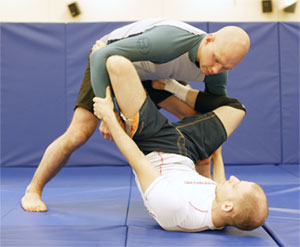 The same position used against a standing opponent. |
 Against a standing opponent, using feet on hips and two hands to control one wrist |
It is difficult to exactly define the Standard Open Guard, because it is such a dynamic and variable position, seamlessly flowing into other guard positions and/or borrowing elements from them. Nevertheless, we first heard the term “Standard Open Guard” from BJJ black belt Marc Laimon, and think that it is a very useful term.
For the sake of this article we define the Standard Open Guard as a position where your legs are not locked around your opponent’s waist, and at least one foot (but often both) is on your opponent’s hips. Having a foot on the opponent’s hip enables you to control the space between you. There are different upper body controls, each offering different sweep, submission and transition setups.
When the gi is worn the Standard Open Guard and the Spider Guard are very closely related: it is hard to use one without using the other at some point. Also keep in mind that in MMA it is imperative to control the opponent’s wrists or elbows, or to push your opponent away with your legs to prevent strikes.
Spider Guard
|
|
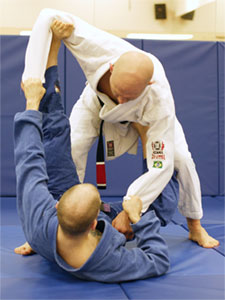 Against a standing opponent, one foot on biceps and the other on the hip |
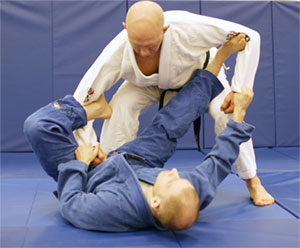 Against a standing opponent using one foot on the bicep and one leg wrapped around the arm |
The Spider Guard is a position mostly used in gi grappling. It is characterized by gripping your opponent’s sleeves and placing at least one foot on his bicep; the other foot can also be placed on the bicep, or it can push the hip, hook behind the knee, encircle the arm, or otherwise control/off balance your opponent. As the Spider Guard controls the opponent while your hips remain free it offers great off-balancing and sweeping options with the triangle choke remaining a constant threat as well.
The Spider Guard is applicable whether your opponent is standing or kneeling. It also transitions well to other guards like the de la Riva Guard, the Upside-Down Guard, the Grasshopper Guard, etc. (which are described later in this article).
Butterfly Guard
|
|
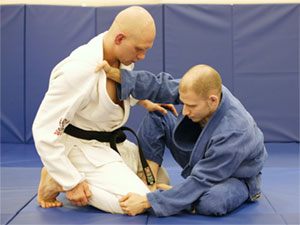 Using a pant leg and lapel cross grip |
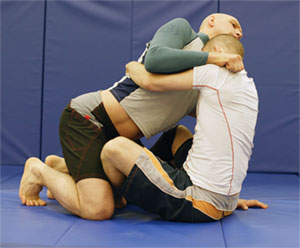 The Butterfly Guard in no gi using a bearhug grip. Occasionally used in MMA, since it is difficult for the opponent to generate a lot of force in his strikes. |
 A very difficult position from which to play the Butterfly Guard (referred to as the TK Guard by early UFC commentators) |
The Butterfly Guard is also called the Sitting Guard (a term used for several different styles of guard) and/or Hooks Guard. Regardless of terminology, it is a very dynamic position with many powerful sweeping options. Submissions from Butterfly Guard are not very common, but some practitioners use the Butterfly Guard to set up leglocks, which are available if you can get a leg between your opponent’s legs. Also, because your legs are not locked in place, it allows smooth and fluid transitions to other positions, such as the X Guard and Half Guard.
You can’t really ‘hang out’ in the Butterfly Guard – you need to be sitting up and actively working to off balance them and threatening them with grips, sweeps, and submissions,. Gaining the upper hand in Butterfly Guard closely resembles clinch-fighting, as both torsos are facing each other at approximately the same height. One should generally NOT lie flat on one’s back (as shown in the third picture), although there are a few practitioners who can make that position work for them.
Butterfly Guard has been used successfully in MMA, but mostly with the exponent using two tight underhooks or a bearhug because these arm positions prevent an opponent from getting the space to strike effectively.
For more information about this position see the ‘Basic’ Butterfly Guard Sweep article, the Buttterfly Guard Crash Course tip, and the Butterfly Guard and X Guard DVD.
De la Riva Guard
|
|
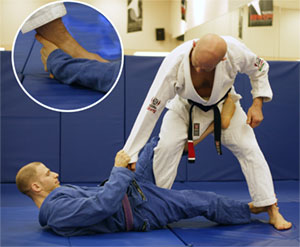 Details on leg and hand placement |
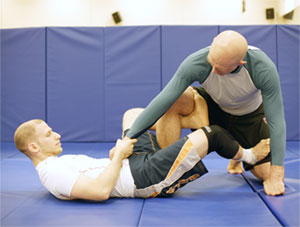 As applied against a kneeling opponent |
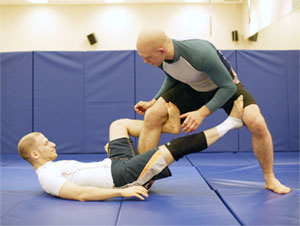 Using a shallow hook and no wrist control against a standing opponent |
This position is named after Ricardo de la Riva, a famous competitor and teacher from the Carlson Gracie lineage, and it is de la Riva himself demonstrating his guard in the first photo. The de la Riva guard is predominantly, but not exclusively, a gi-based position, in which you wrap one of your legs around the outside of your opponent’s lead leg. Your foot can be inserted deeply or shallowly in his knee or hip. The position of your other leg depends on what your opponent is doing and/or on which sweep you are attempting to set up at that moment.
In the de la Riva Guard your hands typically control both his sleeves, or one sleeve and the heel of his lead leg. If you use this position without controlling his wrist or arm you are exposing your legs and feet to a variety of leglocks, so be on alert and move quickly. This position best known for its sweeps, but offers a few transitions into submissions as well.
Reverse de la Riva
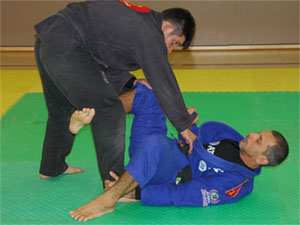
The Reverse de la Riva Guard
Here Ricardo de la Riva demonstrates the Reverse de la Riva Guard, usually used in conjunction with the ”traditional” de la Riva Guard above. It is often employed as a counter when your opponent attempts to cross-slide his knee across your free thigh to pass your guard. In this case you simply switch hooks: instead of your outside leg wrapping his leg you use your inside leg to trap his leg at the knee or thigh. You can also use your free hand to support your own knee instead of grabbing the sleeve.
From the Reverse de la Riva you can sweep your opponent or transition to other open guard positions such as Deep Half Guard and X-Guard.
Cross Guard
|
|
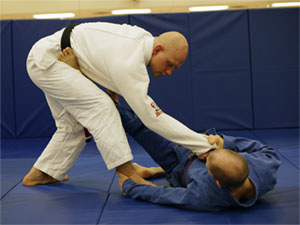 The same grips being used against a standing opponent. |
The Cross Guard is another gi-specific position. It relies on cross-grabbing the opponent’s opposite sleeve with one hand and gripping or underhooking his leg with the other. In the Cross Guard you have a number of sweeping and submission options, the most common being the omo plata submission, omo plata sweeps and the triangle choke. Pe De Pano is probably the most famous exponent of the Cross Guard.
Sitting Open Guard
|
|
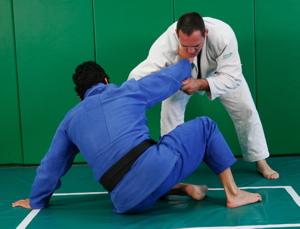 Another view of the body position and stiffarm lapel grip |
Various BJJ practioners use the term Sitting Guard to refer to some very different positions. As used by black belt instructor Joe Moreira (and described in the Strategic Guard book) it refers to an upright posture using a rearward posting arm and a stiff arm on the collar bone using a lapel grip to keep your opponent at a distance. In this position you have the freedom to move left and right, forwards and backwards, come to your feet or go to another style of guard. Typically you will make small adjustments every time your opponent moves, allowing you to counter his guard passing attempts and also to set up various armlocks and chokes.
The term Sitting Guard is also used to describe the Butterfly Guard and/or a sitting half guard position.
Grasshopper Guard

Elliott Bayev demonstrates the Grasshopper Guard
Most commonly attained from Spider Guard or when an opponent is passing with double underhooks, this is a gi-dependent position named by Elliott Bayev. It is characterized by sleeve control and butterfly hooks or crossed ankles, with the opponent’s arms hooked under the legs.
The control over the opponent’s arms and shoulders offers a number of unique sweep, submission and back-taking options. There is always the danger, however, of the opponent passing your guard if you lose your grips or butterfly hooks.
Upside Down Guard
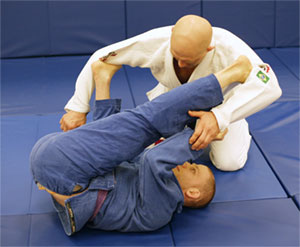
The Upside Down Guard in action
The Upside Down Guard is an unusual position in which the practitioner inverts himself, keeping his feet in contact with his opponent. This can be done either intentionally or in response to an attempted guard pass.
When used in gi competition this position is sometimes maintained for some time; in no gi situations it is more commonly only a momentary, transitional position. In either case, the most common submission from this position is probably the triangle choke, but it also leads into a variety of sweeps and submissions.
The Worm Guard
|
|
|
The Worm Guard is the brainchild of American BJJ phenomenon Keenan Cornelius although it has now been adopted by other guard players as well. It is one expression of using your feet on your opponent’s lapels to manipulate him and prevent him from passing.
In the Worm Guard you free up one hand and one leg on the same side of your body, making it difficult for your opponent to stop your technical standup motion and other sweeps.
Many traditional guard passes are difficult or impossible to use against the Worm Guard. Preventing the initial grip is probably the best idea if facing a Worm Guard player, but once the position is established then not getting swept and trying to break the lapel grip is one of your best options.
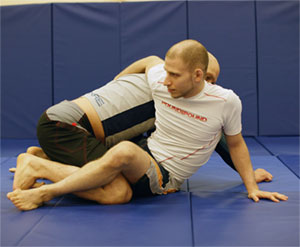
The Octopus Guard in no-gi
The Octopus Guard was named by BJJ and submission grappling competitor Eduardo Telles. In this position you duck under your opponent’s armpit and lock his body down by placing your arm across his back. This position opens up various sweeps and submissions, as well as a clear route to your opponent’s back. With slight variations the Octopus Guard can be applied from the Closed Guard, the Open Guard or even the Half Guard.
Once again, Telles is not the only person to have developed and used this position. BJ Penn, for example, used it to take Matt Hughes’s back in their second battle at UFC 63.
Looking to develop your Open Guard?
There’s probably no better place to start than our legendary Spider Guard Masterclass series, available in both mobile apps and DVD format.
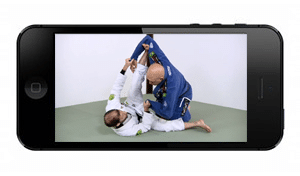
Other articles in this series:
Related articles:
The post A Glossary of Guards Part 2: The Open Guard appeared first on Grapplearts.

